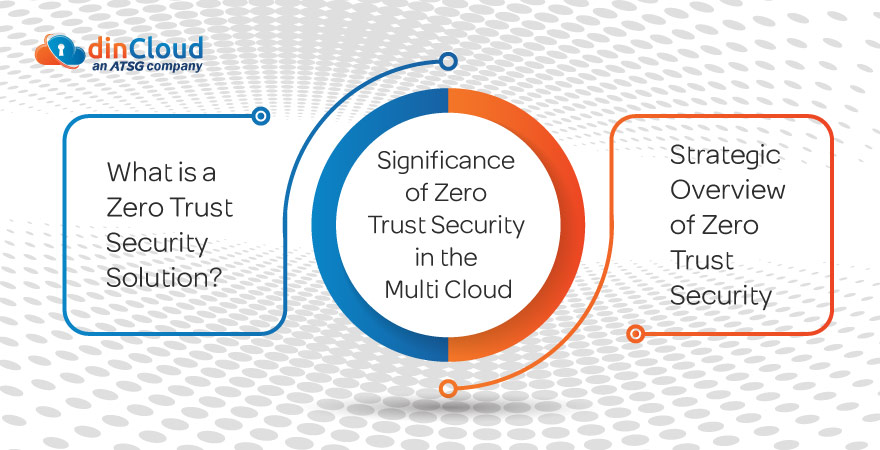The global pandemic greatly helped businesses in an accelerated migration towards the Cloud. There was a significant shift in work structures, and we saw organizations pivot towards remote work environments.
The rapid evolution, of these IT environments, has opened new doors for some security threats as well. Forward-thinking enterprises have been able to tackle this problem quite well. With multi-cloud environments gaining popularity, the perimeter-based traditional security approaches have become obsolete.
New security trends have recently emerged to provide innovative solutions to these evolving IT and cyber security challenges.
Related: Why Zero Trust Security Strategy is Future for Businesses

What is a Zero Trust Security Solution?
Zero Trust security solutions have managed to make Cloud-based infrastructures extremely secure. A Zero Trust security approach makes sure that every single user, inside or outside of an organization’s network, is vetted through an authentication process. It is only upon successful authentication of the user that access to enterprise data, resources and applications is allowed.
Another way of defining Zero Trust Security is, “Trust no one unless authenticated, and make this a repetitive process”.
There is a unanimous agreement regarding the value of Zero Trust security in the business world. According to a study, 83% of the top executives across the globe, have acknowledged the strategic value of Zero Trust security in today’s work environments.
It is crucial that there is a correct implementation of Zero Trust security solution across the multi-cloud environments. Poor implementation and execution can cause productivity lags and still leave the infrastructure susceptible to vulnerabilities.
Related: The Retail Sector Using Zero Trust and Automation to Bolster Security
Strategic Overview of Zero Trust Security
IT specialists and CIOs of companies should be able to answer the following strategically important questions, before applying Zero Trust security solutions across their entire Cloud environments.
- The first question is how the legacy systems will be impacted by Zero Trust security. IT visionaries and key decision makers will have to undergo a full audit of the pre-existing IT environment to eradicate any expected inefficiencies and incompatibilities.
- The second question is that how Zero Trust security will affect the user’s experience. Users have ongoing interactions with IT environments. If they repeatedly have to legitimize their login activity, it will hinder their productivity. Top class Zero Trust solutions will make sure that after confirmation of user’s identity, the authentication hassle will get out of their way, to the best extent possible.
- The third question is that how security can be further increased over time. The repetitive nature of Zero Trust security, forces CIOs to come up with improved ways to enhance security.
- These are some pertinent questions that must be addresses before adopting Zero Trust solutions. Following is a comprehensive five-step process that will help us address all the above-mentioned security related questions.
Related: Zero Trust Security – An Effective Risk Mitigation Model
Step One: Determine What Needs to be Protected
A full-scale audit/ will help us determine what exactly needs to be protected in the multi-cloud environment. This all-encompassing audit will include crucial data, assets, applications and other services. Through this, you will be able to identify sensitive IT resources that need to be immediately secured.
Step Two: Detect Interactions Among Specific Resources
A deep understanding of the interactions among various resources in an enterprise can help us tighten the security grip. This can eventually enhance the long-term security posture of a company.
Step Three: Identify the Appropriate Technological Mix
To cover the entire surface area of an enterprise, Zero Trust security utilizes various technologies and systems. The idea is to protect the infrastructure, data and applications against devastating and complex cyber threats that we face today.
Step Four: Build User-Friendly Security Policies
IT administrators and decision makers must try to strike a balance between providing strong security tools and a smooth user experience. This means offering a protected multi-cloud environment with minimum productivity inhibits.
Step Five: Effectively Manage Networks
Since Zero Trust security is iterative, a change management program can help the relevant stakeholders to have a detailed understanding of this security solution and its importance. This will create a sense of ownership at every tier of the organization.
Related: Pandemic Makes Zero Trust Security a Top Priority
Conclusion
The constantly rising trend of hybrid and multi cloud environments, coupled with mass scale remote work scenarios, are factors that have made the adoption of Zero Trust security solutions a necessity. This will help organizations build and retain a compliant and secure cloud-based infrastructure.
dinCloud, an ATSG company, has a pool of talented Cloud Computing specialists that will help you build an air-tight cloud environment that is built around security at its very core.


